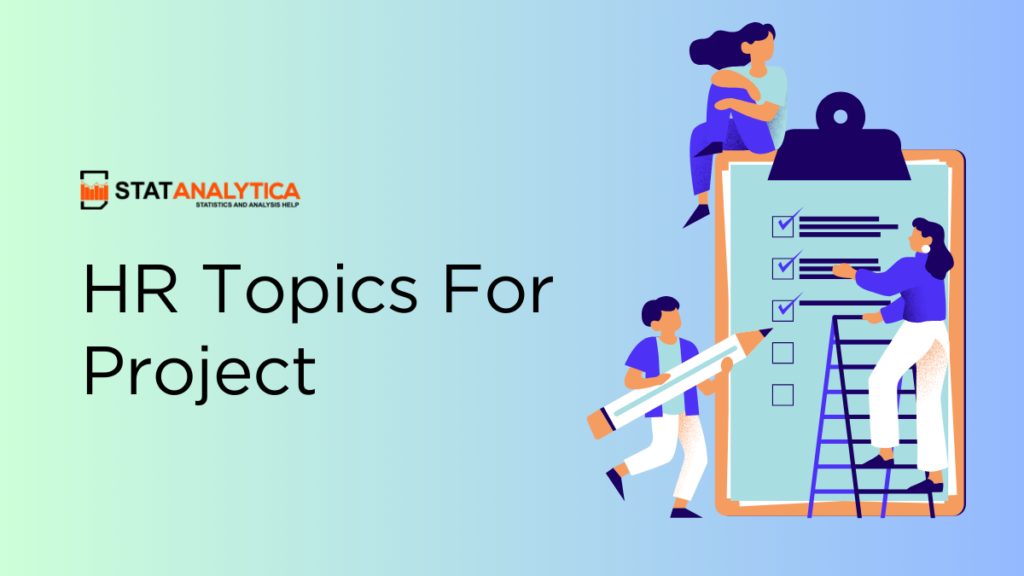Human Resources (HR) is a fascinating and essential field in any organization. If you’re a student and need to work on a project related to HR, this guide will help you understand various topics and ideas you can explore. Let’s dive into some interesting HR topics for projects.

What is Human Resources?
Table of Contents
Human Resources, commonly known as HR, is a department in organizations responsible for managing people. HR professionals handle recruitment, training, employee relations, benefits, and compliance with labor laws.
They play a crucial role in ensuring that a company runs smoothly and that employees are happy and productive.
How Do I Start An HR Project?
Starting an HR project involves several key steps to ensure it’s well-planned and executed effectively. Here’s a comprehensive guide to help you get started:
1. Choose a Topic
Identify Your Area of Interest
Select an HR topic that interests you. Consider areas where you have some background knowledge or a strong curiosity.
Research Potential Topics
Look for current trends in HR, read articles, and talk to professionals to gather ideas. Make a list of potential topics.
Narrow Down Your Topic
Pick a particular part of the topic that you can handle within the limits of your project. Make sure it’s not too wide or too narrow.
2. Define the Project Objectives
Set Clear Goals
Determine what you want to achieve with your project. Your objectives should be SMART (Specific, Measurable, Achievable, Relevant, Time-bound).
Understand the Purpose
Consider why this project is important. What problem are you trying to solve or what knowledge are you aiming to gain?
3. Conduct Preliminary Research
Gather Information
Read books, articles, and research papers related to your topic. Use credible sources such as academic journals, HR websites, and industry reports.
Identify Key Concepts
Note down important concepts, theories, and case studies that relate to your topic. This will form the foundation of your project.
4. Develop a Project Plan
Create a Timeline
Break down the project into smaller tasks and set deadlines for each. This helps in managing your time effectively.
Outline Your Project Structure
Plan the structure of your project. A typical structure includes:
- Introduction
- Literature Review
- Methodology
- Analysis
- Findings/Results
- Conclusion
- Recommendations
5. Gather Data
Primary Data Collection
If your project involves collecting primary data, decide on the methods (e.g., surveys, interviews, observations). Prepare your data collection tools like questionnaires or interview guides.
Secondary Data Collection
Use existing data from reliable sources. Ensure you properly cite these sources in your project.
6. Analyze the Data
Organize Your Data
Arrange your data in a systematic way for analysis. Use tables, charts, or software tools to help with this process.
Interpret the Results
Study the data to find patterns, trends, and important information. Connect what you discover with what others have already studied and with the goals of your project.
7. Write the Project Report
Introduction
Provide background information on your topic and state the objectives of your project.
Literature Review
Summarize existing research related to your topic. Highlight gaps that your project aims to fill.
Methodology
Describe the methods you used to collect and analyze data. Include details about your sample, tools, and procedures.
Analysis and Findings
Present your data analysis and discuss the findings. Use visuals like graphs and tables to support your points.
Conclusion
Summarize your findings and their implications. Explain how they add to what we already know.
Recommendations
Provide practical recommendations based on your findings. Suggest further areas for research.
References
List all the sources you cited in your project. Use a consistent citation style.
8. Review and Edit
Proofread Your Work
Check for grammatical errors, spelling mistakes, and consistency in formatting.
Seek Feedback
Share your draft with teachers, peers, or mentors for feedback. Make necessary revisions based on their suggestions.
Finalize the Report
Ensure all sections are complete and well-organized. Confirm that your report meets all the requirements and guidelines provided.
9. Prepare for Presentation
Create a Presentation
Prepare a presentation summarizing the key points of your project. Use visuals like slides, charts, and diagrams to make it engaging.
Practice Your Presentation
Rehearse your presentation multiple times. Get ready to respond to questions asked by your audience.
10. Submit Your Project
Follow Submission Guidelines
Ensure you adhere to any submission guidelines provided by your teacher or institution.
Meet Deadlines
Submit your project on time. Double-check that all required materials are included.
50 HR Topics For Project For Students: Category Wise
Recruitment and Selection
- Effective Recruitment Strategies for Startups
- The Role of Social Media in Recruitment
- Artificial Intelligence in Talent Acquisition
- Campus Recruitment: Best Practices
- Diversity Hiring: Challenges and Solutions
- Employee Referral Programs: Benefits and Drawbacks
- The Impact of Employer Branding on Recruitment
- Virtual Interviews: Techniques and Tools
- The Role of Psychometric Testing in Selection
- Onboarding Processes for New Employees
Training and Development
- Designing Effective Training Programs
- The Impact of E-Learning on Employee Training
- Training Needs Analysis: Methods and Tools
- Soft Skills Training: Importance and Methods
- Mentorship Programs in the Workplace
- The Role of Continuous Learning in Career Development
- Measuring Training Effectiveness
- Leadership Development Programs
- Technical Skills Training in IT Companies
- The Use of Virtual Reality in Employee Training
Performance Management
- Implementing 360-Degree Feedback
- Setting SMART Goals for Employee Performance
- The Role of Performance Appraisals in Employee Motivation
- Using Key Performance Indicators (KPIs)
- Employee Recognition Programs
- Managing Underperformance: Strategies and Techniques
- The Impact of Performance Reviews on Employee Morale
- Linking Performance Management to Compensation
- Real-Time Performance Tracking Tools
- The Role of Self-Assessment in Performance Management
Employee Relations
- Building Positive Employee Relations
- Conflict Resolution in the Workplace
- The Impact of Corporate Culture on Employee Relations
- Employee Engagement Strategies
- The Role of Communication in Employee Relations
- Handling Employee Grievances Effectively
- Work-Life Balance Initiatives
- Employee Feedback Mechanisms
- Team Building Activities and Their Impact
- Managing Workplace Stress
Compensation and Benefits
- Designing Competitive Compensation Packages
- The Role of Benefits in Employee Retention
- Health and Wellness Programs in the Workplace
- Pay Equity and Its Importance
- The Impact of Financial Incentives on Performance
- Flexible Benefits Plans
- Retirement Planning and Benefits
- Employee Stock Ownership Plans (ESOPs)
- The Role of Bonuses and Commissions
- Trends in Employee Benefits Packages
Best 3 Detailed Examples of HR Projects
Example 1: Creating a Recruitment Plan
- Understand the Job Requirements
Identify the job roles that need to be filled and understand the skills required for these positions.
- Attract Candidates
Decide how to attract potential candidates. This could be through job postings, campus recruitment, or social media.
- Screening and Selection
Design a process to screen applications and select the best candidates for interviews.
- Interview Process
Develop a set of interview questions and a scoring system to evaluate candidates fairly.
Example 2: Designing a Training Program
- Identify Training Needs
Conduct a survey or interview employees to understand what training they need.
- Set Training Objectives
Define what the training program should achieve. For example, improving customer service skills.
- Develop Training Materials
Create materials such as presentations, handouts, and quizzes.
- Implement the Training
Organize training sessions, either in-person or online.
- Evaluate the Training
Collect feedback from participants to see if the training was effective.
Example 3: Performance Review System
- Define Performance Criteria
Identify the key performance indicators
- Develop Review Forms
Create forms that managers can use to evaluate employee performance.
- Schedule Regular Reviews
Set up a schedule for regular performance reviews, such as quarterly or annually.
- Provide Feedback
Train managers on how to give constructive feedback to employees.
- Set Goals
Work with employees to set achievable goals for their development.
Tips for Successful HR Projects
- Research Thoroughly: Gather information from various sources like books, articles, and interviews with HR professionals.
- Be Creative: Try to think creatively and come up with new and original ideas and solutions.
- Stay Organized: Keep your project well-organized with clear headings, subheadings, and bullet points.
- Use Real-Life Examples: Incorporate real-life examples to make your project more relatable and interesting.
- Seek Feedback: Ask teachers or peers for feedback to improve your project before the final submission.
Top 5 Tools To Make HR Project
- Microsoft Excel: For organizing data, creating charts, and performing basic data analysis.
- Google Forms: For designing and distributing surveys to collect primary data.
- Trello: For project management and keeping track of tasks and deadlines.
- SPSS (Statistical Package for the Social Sciences): For advanced statistical analysis of data.
- Canva: For creating visually appealing presentations and infographics.
Conclusion
Human Resources is a dynamic field with numerous topics that you can explore for your project. Whether it’s recruitment, training, performance management, or employee relations, there are plenty of interesting areas to research and present.
By following the tips and examples provided in this guide on HR topics for projects, you’ll be well on your way to creating an outstanding HR project.
Good luck with your HR project, and remember to have fun while learning about this important field!


